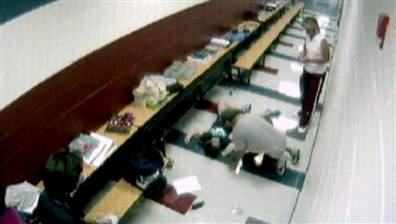Northport students screened for heart conditions Saturday as part of Heart Screen New York, an initiative in conjunction with the Louis J. Acompora Memorial Foundation.
‹ Back to Article
Two hundred and forty students between 14 and 24 years old were screened for heart conditions at Northport High School on Saturday as part of Heart Screen New York, an initiative in conjunction with the Louis J. Acompora Memorial Foundation, Dominic A Murray 21 Memorial Foundation, and Mount Sinai Hospital.
Students were given a heart physical exam, blood pressure tests, electrocardiograms, and, in some cases, echocardiograms, by medical staff from New York College of Osteopathic Medicine assisted by local volunteers. Some students also participated in a CPR/AED education station.
"The event was a huge success and we are looking forward to bringing the heart screening to other area schools," said Louis J. Acompora Memorial Foundation Founder Karen Acompora.
Karen lost her 14-year-old son, Louis, to sudden cardiac arrest (SCA) in 2000 following an injury in a lacrosse game. Each year approximately 250,000 people die from sudden cardiac arrest). The vast majority of these deaths are caused by the initiation of an abnormal heart rhythm called ventricular fibrillation (VF), a chaotic heart rhythm that results in a loss of circulation and delivery of oxygen to the body tissues. Louis Acompora suffered an episode of VF called commotio cordis.
The Foundation seeks to reduce the incident of preventable deaths from cardiac arrest through awareness campaigns and by providing access to life-saving defibrillators. For more information, visit www.la12.org.
Students were given a heart physical exam, blood pressure tests, electrocardiograms, and, in some cases, echocardiograms, by medical staff from New York College of Osteopathic Medicine assisted by local volunteers. Some students also participated in a CPR/AED education station.
"The event was a huge success and we are looking forward to bringing the heart screening to other area schools," said Louis J. Acompora Memorial Foundation Founder Karen Acompora.
Karen lost her 14-year-old son, Louis, to sudden cardiac arrest (SCA) in 2000 following an injury in a lacrosse game. Each year approximately 250,000 people die from sudden cardiac arrest). The vast majority of these deaths are caused by the initiation of an abnormal heart rhythm called ventricular fibrillation (VF), a chaotic heart rhythm that results in a loss of circulation and delivery of oxygen to the body tissues. Louis Acompora suffered an episode of VF called commotio cordis.
The Foundation seeks to reduce the incident of preventable deaths from cardiac arrest through awareness campaigns and by providing access to life-saving defibrillators. For more information, visit www.la12.org.











